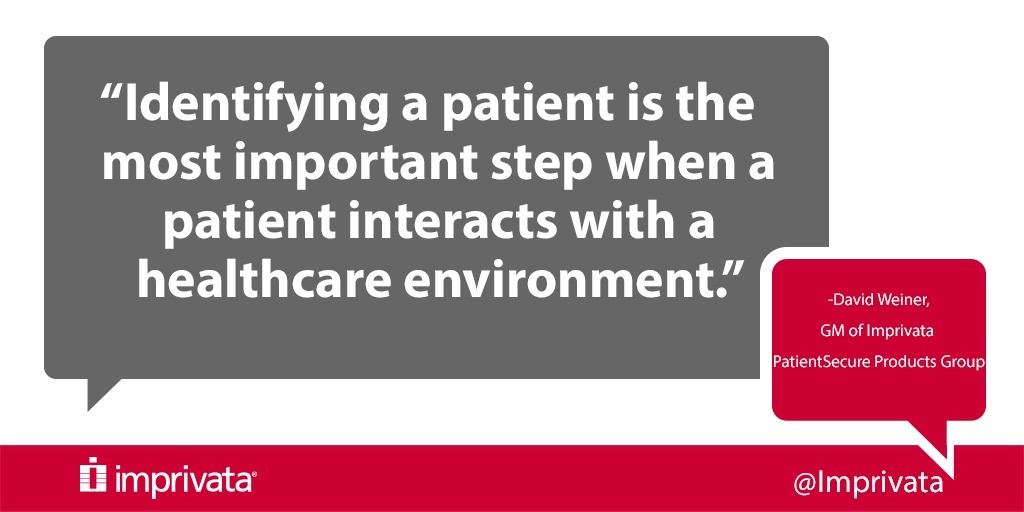Eliminating Patient Identification Errors
As the healthcare industry has moved from paper to electronic records for the past decade, hospitals have continuously had to meet increased federal regulations related to the use of electronic health records. With the increased digitizing of health records, new challenges are being presented by duplicate medical records, language barriers, and disparate systems. Research shows that 7 to 10 percent of patients are misidentified when a record is accessed, and 6 percent of those patients can suffer medical harm or identity theft because of it.
I recently participated in a webinar with Molly Gamble, Editor-in-Chief of Becker’s Hospital Review, and David Weiner, GM of Imprivata PatientSecure Products Group, where we highlighted why a biometric identification solution at patient registration is the most successful way to correctly identify a patient and protect their privacy and information.
Is patient safety in jeopardy?
Over the last two years, the Joint Commission has stated that the number one area where patient safety improvement is needed is accurate patient identification. It is critical for us clinicians to be certain we are treating the correct patient with the correct data at hand. Not having a patient’s complete and accurate medical history can result in adverse events and patient harm. Misidentification can lead to detrimental medication interactions, duplicate studies with dangerous side effects, missed diagnoses, and even improper treatments and procedures. Once an error is made in identification and a patient’s chart becomes corrupted, the downstream effects can be exacerbated as more and more decisions are based on inaccurate information. If I thought you had a negative screening test because someone entered that result on the wrong patient, I might not check it again until it is too late to treat your end-stage cancer. There are thousands of similar examples.
The financial burdens of patient identification errors
In addition to life-threatening issues, patient identification errors can lead to financial burdens for the hospital and medical identity fraud. Hospitals spend hundreds of thousands of dollars every year in an effort to merge duplicate charts and remove erroneous information when charts are mistakenly combined (chart “overlays”). Fraud is a costly issue as well. In 2014, 2.3 million people were impacted by medical identity fraud, 21 percent more than the year before. Unlike credit card fraud, patient identity theft can be permanent and difficult to correct, despite significant efforts. The average out of pocket cost for someone impacted by identify theft is approximately $13,000, not including other personal costs and charges towards the healthcare organization.
Conversely, having the correct information immediately available can improve patient safety and save lives. Simply verifying that patients are matched correctly to their electronic data on file ensures that doctors and nurses are able to make the best decisions possible to help diagnose and treat them properly. The more dependent we become on electronic records, the more positive patient identification becomes important moving forward.
The biometric identification solution: Imprivata PatientSecure
Hospitals today seek to prevent patient identification errors by implementing new systems and policies. However, many organizations are still not always able to guarantee a match between the medical data and the correct person. We at Imprivata believe that the patients themselves are their own best identifier. Imprivata’s PatientSecure links a person’s biometric to their medical record providing a 1:1 correlation between the patient and their data. Biometrics can work across disparate systems and can even positively identify a person who is unconscious or unresponsive to ensure proper diagnosis and treatment.
Harris Health System in Houston, Texas did a study to support the implementation of PatientSecure. They went into their Master Patient Index of 3.4 million people which had over 70,000 patients with the same date of birth, and 231 of those had the same first name. These numbers make the registration selection process much more difficult and increase the chance for misidentification and medical fraud.
More than 350 hospitals across the country are successfully using PatientSecure to positively identify millions of patients. Healthcare organizations have been able to increase patient safety, reduce duplicate medical records and overlays, and protect patients’ privacy and information.

Listen to the webinar here to learn more about Imprivata PatientSecure.
